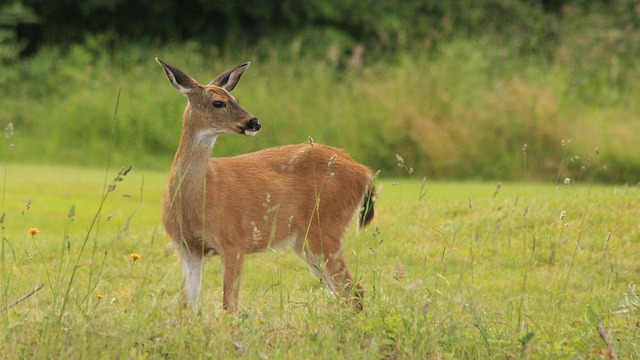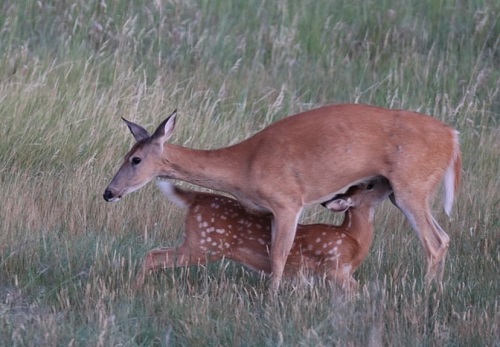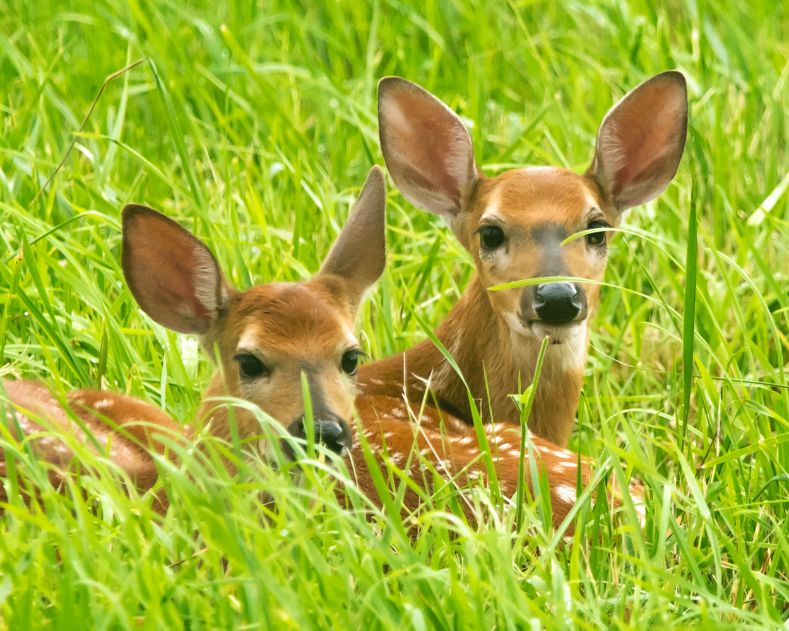New life on Earth is a result of reproduction. The gestation period varies according to the species of deer you’re discussing in the world of deer. The gestation period, or the time a doe is pregnant, lasts between 200 and 205 days in many species of deer. The number of days can reach 230 or even 286 in some species. Deer breed only during certain times of the year. For more details, please keep reading.
Deer
The particular species has an effect on how long deer gestation lasts. The biggest deer species are moose, while muntjac and fallow deer are among the smallest. All deer, regardless of species, have hooves, and chambered stomachs, and eat plants.
Humans regularly hunt and consume all types of deer, along with wolves and occasionally bears. Native populations exist on all continents, with the exception of Antarctica and Australia, where they are found all over the world.
Appearance
Deer are four-legged animals with evenly spaced hooves at the end of each leg. They spend their time avoiding predators, searching for food, and producing more deer because they were designed to run.
Except for water deer in Asia, most male deer only have antlers for a portion of the year. Bone, blood vessels, and nerves are the main components of the antlers, which act as both a sign of age and a sign of dominance.
The only males allowed to mate with females are those who have the best set of antlers. Deer can be light tan to dark brown in color, with some species, like the fallow deer, continuing to have white spots on their bodies as they age.
Size
Small-to-large ungulates (animals with hooves) include deer. Their bodies are graceful, and their legs are long. Elk and moose are the family’s biggest members. Moose has a maximum height at the shoulder of seven feet and a maximum weight of 1,500 pounds.
Furthermore, they frequently have bodies that are longer than seven feet. The largest elk can weigh up to close to 1,000 pounds and are about five feet tall at the shoulder. Their bodies can grow up to eight feet long.
The muntjac is the smallest deer; they weigh no more than a medium-sized dog and grow to heights under two feet at the shoulder.
Distribution And Habitat
Native deer species can be found in North America, South America, Europe, Asia, and some regions of Africa. Deer favor areas with an abundance of forbs, grasses, or plants with leaves to consume. Mule deer and white-tailed deer can be found in the foothills surrounding many urban and suburban areas in North America.
Only one species of deer, the Barbary stag, can be found in Africa, and it lives in the Atlas Mountains. Reindeer abound in the cold tundra and boreal forests of Canada’s far north.
Behavior
Although they have no natural defenses, deer are born able to walk. As they develop, they learn to pay attention, as well as to keep an eye out for potential threats like predators. Adult moose, the biggest deer species, are not particularly frightened of lone wolves or bears.
Even when confronted by humans, female moose have been known to defend their calves with violence. At particular times of the year, some species, such as elk, form herds. Usually, these herds are split up into males and pregnant females.
When Is The Deer Breeding Season?
Before the breeding season starts, both female and male deer undergo significant changes in their hormone levels and reproductive organs. Each year’s fall is when deer go through their rut or mating season.

Female deer have a relatively brief estrous cycle. For most types of deer, it starts in the fall and lasts from October to December. Only a few days a year are available for the doe to become pregnant.
If a deer has recently become pregnant, it can be challenging to tell. You have no chance of determining whether a doe is carrying young by looking at her until she has been pregnant for at least three months.
Hunting during the gestation season is therefore entirely prohibited. The reason why many hunters target male deer (along with the fact that their antlers are sought-after) is because of how crucial this is to ensure the health and sustainability of deer generations.
How Long Do Deer Stay Pregnant?
The duration of each deer’s gestation varies. The length of pregnancy tends to increase with species size. Female moose give birth to one or two calves after 230–250 days of gestation. Elk typically give birth to one calf after a 240–265 day gestation.
One or two calves are born after a 200–220 day pregnancy in reindeer. Mule deer give birth to one to two calves after a 200-day gestation period. The gestation period of smaller deer is shorter.
Factors Affecting The Deer Gestation Period
The lengths of the deer’s gestation can be influenced by a number of factors. The general guideline for the gestation period also varies among the different species of deer:
White Tail Deer Gestation Period
Whitetail deer typically give birth after 200 days of gestation. This is due to the species’ propensity for cold-climate native habitats.
Each spring, a doe of the whitetail species can give birth to one to three fawns. The best time of year for deer to give birth is in the spring because the weather is mild and hospitable and there is plenty of food available.
Read More: Albino Whitetail Deer: Everything You Should Know
Red Deer Gestation Period
Asia, northwest Africa, and other parts of the world are home to red deer. They go by the name Elk frequently in North America. Red deer typically have a 236-day gestation period.
Later in the spring, the female will typically give birth to one to three fawns, also known as calves. Male and female red deer typically live apart from one another, with the exception of the breeding season.
Roe Deer Gestation Period
Generally speaking, European nations are home to the roe deer species. Normally, it takes 290 days for it to complete its gestation. Each May, roe deer typically give birth to one to three fawns.
Mule Deer Gestation Period
About seven months pass during the mule deer’s gestation. During her first pregnancy, a mule deer female typically gives birth to one fawn. Every subsequent pregnancy a female mule deer has in the United States usually results in twins.
Gestation Period Of Fallow Deer
Asia, Europe, the US (especially Texas), and the UK are all home to fallow deer. Between 230 and 245 days pass during the gestation period of the Fallow Deer doe.
How Many Times Do Deer Give Birth Each Year?
In contrast to humans, a herd of deer, elk, or bucks has a much larger population because they reproduce prolifically to keep the numbers of their species high. Learn how many fawns a mother deer gives birth to during her pregnancy.
Deer typically give birth to a few fawns. Whether in America or the southern hemisphere, the same case is observed everywhere on Earth. The mother typically gives birth to one fawn during the first reproductive cycle.

The beginning of winter is when reproduction is most frequently seen. The female estrus period, which is an essential stage of the reproductive process, begins in the fall and can be seen beginning in August. It peaks in November.
Although it is quite uncommon, some deer species animals have been observed to start the breeding process in the summer, specifically in June. As males and females get older, a mother deer may give birth to more than two or three fawns during the pregnancy.
The herd directs these young fawns as they feed and flee from predators during the spring, summer, and fall as they develop quickly.
What Takes Place Before The Female Mats?
Mother’s bodies go through specific physiological and hormonal changes as part of the unique process of bringing new life to the planet.
When the body’s production of photoperiod declines, the estrus cycle starts. The estrus cycle is supported in different ways by other female hormones like progesterone and estrogen. Estrogen concentrations rise while progesterone levels fall.
After a few iterations, the cycle comes to an end when the doe becomes pregnant and successful breeding occurs. The cycle frequently continues until spring, usually in March for mule deer or whitetail deer.
Deer Breed Seasonally: Why?
Some species of animals reproduce annually, while others do so every other year, and still, others only do so during certain times of the year. There are several variables that affect the breeding process.
The change in the weather and climate is what causes deer to start mating. The physiological characteristics of animals are impacted by the same factors that change the climatic conditions.
The LHRH, also known as the luteinizing hormone-releasing hormone, which together with melatonin is responsible for initiating the birth cycle, is largely triggered by changes in day length, rainfall, and weather.
How Do You Know If A Doe Is Pregnant?
Due to changes in the physiological characteristics of the body, it is very simple to recognize a pregnant whitetail deer.
The deer’s belly is the best indicator of whether it is pregnant. A deer that is pregnant will have a visibly large belly. In the months following breeding, this is best observed. For the baby deer that is developing inside the doe’s body, the doe may be resting more than usual and eating more than usual.
Hunters Must Understand Deer Reproduction And Gestation
Because they are killed by predators or even hunters, many fawns will not live to adulthood. When a deer reaches adulthood, it has a chance of living for up to 20 years in the wild if it is fortunate and avoids being eaten by a predator or killed by a hunter. If kept in captivity, deer can live for up to 30 years.
Understanding deer gestation and reproduction is everyone who hunts deer. You could easily endanger the viability of a deer generation and have an adverse effect on the health of your local herd if you choose your hunting tactics and timing without sufficient knowledge.

